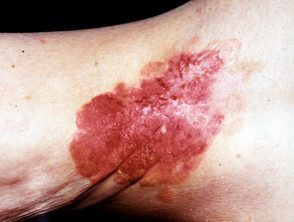What is extramammary Paget's disease of the skin?
Extramammary Paget's disease of the skin is a rare intraepithelial Cancer characterized by a chronic eczema-I like it eruption about armpits or anogenital male and female regions. Under the microscope, extramammary Paget's disease is very similar to the more common Paget's disease of the breast that occurs in the breast.
Who gets extramammary Paget's disease?
Extramammary Paget's disease occurs most frequently in the vulva of women between 50 and 60 years old. It can also affect the armpit and the anogenital area in males of similar age. It has been observed to be more common in Asians than Europeans and very rare in African Americans.
How is extramammary Paget's disease classified?
Extramammary Paget disease of the skin has been classified into several subtypes.
- Type 1a primary cutaneous Extramammary Paget's disease arises from apocrine glands within epidermis (in the place) or underlying skin appendices.
- Primary cutaneous extramammary Paget's disease type 1b (15-25%) is associated with invader Paget's disease or adenocarcinoma in situ.
- Type 2 extramammary Paget's disease arises from an underlying anal or rectal adenocarcinoma.
- Type 3 extramammary Paget's disease originates from adenocarcinoma of the bladder.
Sometimes extramammary Paget's disease has been present for 10-15 years before evidence of cancer or metastasis appears.
What are the clinical features of extramammary Paget's disease?
The most common symptom of extramammary Paget's disease of the skin is mild to severe itching of a injury found around the groin, genitals, perineum or perianal zone. Pain and bleeding can occur from scratching injuries that have been around for a long time. Thickened plates can form and turn red, scaly and crispy
Extramammary Paget's disease

Armpit

Vulva

Scrotum
What sites are affected?
In women, the most common area involved is the vulva. The first symptoms are usually itching and burning in one or more persistent plaques. These can spread to the labia, pubis, vagina, and thighs. Perianal lesions can extend to the anal canal.
In men, the most common area is the scrotum followed by perianal disease, penis, and groin.
The armpit is a rare site for extramammary Paget disease of the skin.
The location of extramammary Paget's disease is useful in predicting the associated cancer risk. For example, 25–35% from extramammary Paget's disease arising near the anus is associated with underlying colorectal cancer.
How is extramammary Paget's disease diagnosed?
Skin biopsy of the lesion is done to get an accurate diagnosis of extramammary Paget's disease, as there are several other genital skin diseases that may appear similar. Below microscopy, the presence of Paget cells along with other histological The findings confirm the diagnosis. Special spots may be necessary to distinguish Paget's disease from early melanoma (melanoma in situ). See extramammary Paget's disease pathology.
Other tests may include:
- Assessment lymph nodes by ultrasound scan or fine needle Aspire
- Look for other malignancies, including Pap smear (cervical smear), pelvic imaging to detect underlying cancer, colonoscopy, mammogram
What is the treatment for extramammary Paget's disease?
Wide local excision, vulvectomy or, if available, margin-controlled surgical excision (Mohs micrographic surgery) is the standard treatment for extramammary Paget disease. Paraffin sections are preferred over frozen sections. The margin is sometimes difficult to define when the lesions spread sporadically throughout the anogenital region. Reconstruction may require skin graft or flap repair.
Reappearance is common (30–50%), so patients should be reexamined every three months after surgery for the next two years, after which yearly follow-ups are recommended. Recurrence usually leads to further surgery.
Non-surgical treatments for recurrent the disease may include:
- Radiotherapy
- To be ablation
- Photodynamic therapy
- 5-fluorouracil cream
-
Imiquimod cream.
What is the prognosis for extramammary Paget's disease?
Paget's disease has a low mortality. Forecast it is worse if there is underlying cancer, the patient is over 70 years old, and Paget's disease is in the anal region.
